Biography
Born in Springfield, New York, in 1835 Oliver graduated from Union College in Schenectady, New York.

Springfield is a town in Otsego County, New York, United States. The population was 1,358 at the 2010 census.

Union College is a private, non-denominational liberal arts college located in Schenectady, New York. Founded in 1795, it was the first institution of higher learning chartered by the New York State Board of Regents. In the 19th century, it became the "Mother of Fraternities", as three of the earliest such organizations were established there. After 175 years as a traditional all-male institution, Union College began enrolling women in 1970.
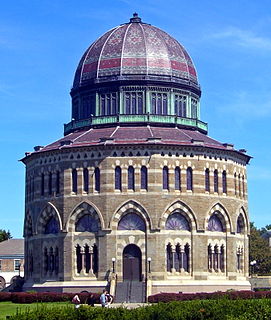
Schenectady is a city in Schenectady County, New York, United States, of which it is the county seat. As of the 2010 census, the city had a population of 66,135. The name "Schenectady" is derived from a Mohawk word, skahnéhtati, meaning "beyond the pines". Schenectady was founded on the south side of the Mohawk River by Dutch colonists in the 17th century, many from the Albany area. They were prohibited from the fur trade by the Albany monopoly, which kept its control after the English takeover in 1664. Residents of the new village developed farms on strip plots along the river.
He studied law, was admitted to the bar and commenced practice in Penn Yan, New York in 1838. He served as judge of the Court of Common Pleas from 1843 to 1847. In 1846 he was judge of the Yates County surrogate and county courts.

Admission to the bar in the United States is the granting of permission by a particular court system to a lawyer to practice law in the jurisdiction and before those courts. Each U.S. state and similar jurisdiction has its own court system and sets its own rules for bar admission, which can lead to different admission standards among states. In most cases, a person is "admitted" or "called" to the bar of the highest court in the jurisdiction and is thereby authorized to practice law in the jurisdiction. In addition, Federal Courts of the United States, although often overlapping in admission standards with states, set their own requirements for practice in each of those courts.
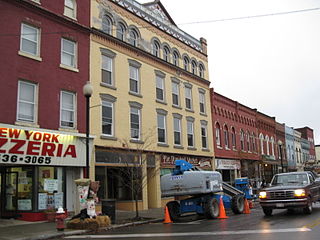
Penn Yan is an incorporated village in Yates County, New York, United States. The population was 5,159 at the 2010 census. It is the county seat of Yates County and lies at the north end of the east branch of Keuka Lake, one of the Finger Lakes.
The New York Court of Common Pleas was a state court in New York. Established in the Province of New York in 1686, the Court remained in existence in the Province and, after the American Revolution, in the U.S. state of New York until it was abolished in 1894.
Oliver was elected as a Democrat to the Thirty-third and Thirty-fourth Congresses (March 4, 1853 – March 3, 1857). He served as chairman of the Committee on Invalid Pensions (Thirty-fourth Congress).

The Democratic Party is one of the two major contemporary political parties in the United States, along with the Republican Party. Tracing its heritage back to Thomas Jefferson and James Madison's Democratic-Republican Party, the modern-day Democratic Party was founded around 1828 by supporters of Andrew Jackson, making it the world's oldest active political party. The Democrats' dominant worldview was once social conservatism and economic liberalism while populism was its leading characteristic in the rural South. In 1912, Theodore Roosevelt ran as a third-party candidate in the Progressive Party, beginning a switch of political platforms between the Democratic and Republican Party over the coming decades, and leading to Woodrow Wilson being elected as the first fiscally progressive Democrat. Since Franklin D. Roosevelt and his New Deal coalition in the 1930s, the Democratic Party has also promoted a social liberal platform, supporting social justice.

The Thirty-third United States Congress was a meeting of the legislative branch of the United States federal government, consisting of the United States Senate and the United States House of Representatives. It met in Washington, D.C. from March 4, 1853, to March 4, 1855, during the first two years of the administration of U.S. President Franklin Pierce. During this session, the Kansas–Nebraska Act was passed, an act that soon led to the creation of the Republican Party. The apportionment of seats in the House of Representatives was based on the Seventh Census of the United States in 1850. Both chambers had a Democratic majority.

The Thirty-fourth United States Congress was a meeting of the legislative branch of the United States federal government, consisting of the United States Senate and the United States House of Representatives. It met in Washington, D.C., from March 4, 1855, to March 4, 1857, during the last two years of Franklin Pierce's presidency. The apportionment of seats in the House of Representatives was based on the Seventh Census of the United States in 1850. The Whig Party, one of the two major parties of the era, had largely collapsed, although many former Whigs ran as Republicans or as members of the "Opposition Party." The Senate had a Democratic majority, and the House was controlled by a coalition of Representatives led by Nathaniel P. Banks, a member of the American Party.
He was an unsuccessful candidate on the American Party ticket for reelection in 1856 to the Thirty-fifth Congress. He engaged in agricultural pursuits and also in the practice of law.
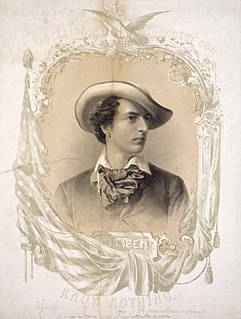
The Native American Party, renamed the American Party in 1855 and commonly known as the Know Nothing movement, was an American nativist political party that operated nationally in the mid-1850s. It was primarily anti-Catholic, xenophobic, and hostile to immigration, starting originally as a secret society. The movement briefly emerged as a major political party in the form of the American Party. Adherents to the movement were to reply "I know nothing" when asked about its specifics by outsiders, thus providing the group with its common name.
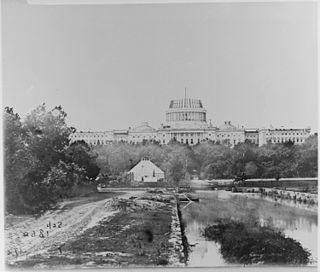
The Thirty-fifth United States Congress was a meeting of the legislative branch of the United States federal government, consisting of the United States Senate and the United States House of Representatives. It met in Washington, D.C. from March 4, 1857, to March 4, 1859, during the first two years of James Buchanan's presidency. The apportionment of seats in the House of Representatives was based on the Seventh Census of the United States in 1850. Both chambers had a Democratic majority.
Oliver again served as county judge and surrogate judge from 1872 to 1877. He died in Penn Yan on March 6, 1889. He was interred in Penn Yan's Lake View Cemetery.
This page is based on this
Wikipedia article Text is available under the
CC BY-SA 4.0 license; additional terms may apply.
Images, videos and audio are available under their respective licenses.

Henry Allen Foster was an American lawyer and politician from New York. He was a United States Senator from 1844 to 1845.

Thomas Tredwell was an American lawyer and politician from Plattsburg, New York. He served in the New York State Senate and represented New York in the United States House of Representatives from 1791 to 1795.
William Morrison Oliver was an American politician, and a United States Representative for the state of New York, and Acting Lieutenant Governor of New York.

Joseph McCrum Belford was an American politician and a United States Representative from New York.
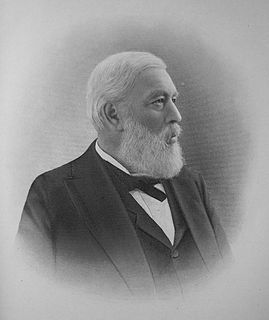
Orange Jacobs was an American lawyer, newspaper publisher, and politician. His career in government centered on the Territory of Washington, for which he served as a delegate to the U.S. Congress, chief justice of the territory's supreme court, mayor of Seattle, and other roles.

William Ellis Niblack was a U.S. Representative from Indiana

Andrew DeWitt Bruyn was a U.S. Representative from New York.
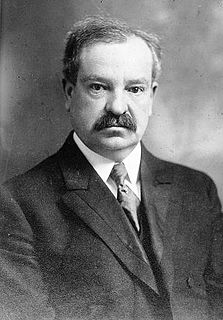
Arthur Sidney Tompkins was a U.S. Representative from New York, and a justice of the New York Supreme Court.
Dorrance Kirtland was a U.S. Representative from New York.

Francis Smith Edwards was a U.S. Representative from New York.
Smith Meade Purdy was a U.S. Representative from New York.

Orsamus Benajah Matteson was a U.S. Representative from New York.
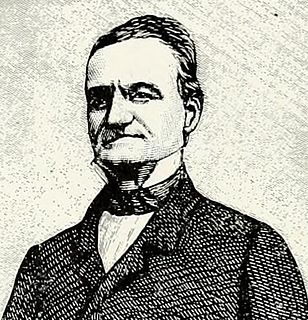
Samuel Birdsall was an American politician and a U.S. Representative from New York.

Sidney Tracy Holmes was a U.S. Representative from New York.
Thomas Cutting Love was a U.S. Representative from New York.

William Henry Kelsey was a U.S. Representative from New York.

Warren Brewster Hooker was a U.S. Representative from New York.

Daniel Morris was a U.S. Representative from New York during the American Civil War.
Mordecai Oliver was an attorney and two-term U.S. Representative from Missouri.

Andrew Scott Sloan, or A. Scott Sloan, was a United States Representative from Wisconsin and brother of fellow congressman Ithamar Conkey Sloan.
























